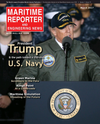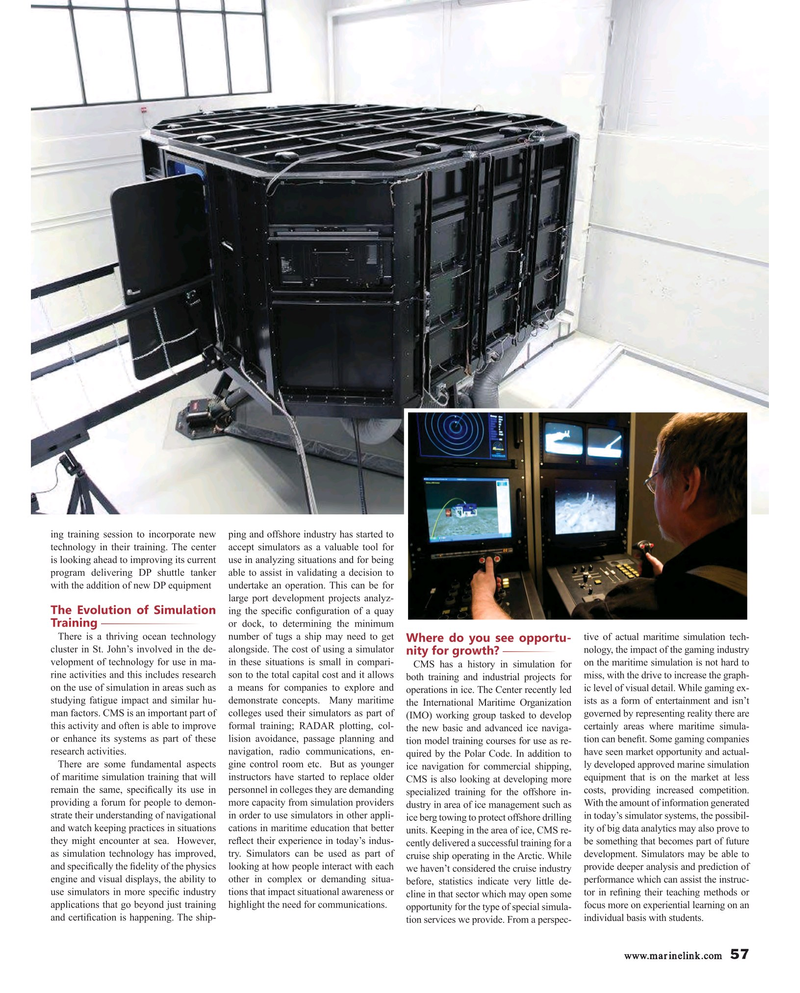
Page 57: of Maritime Reporter Magazine (March 2017)
U.S. Navy Quarterly & Maritime Simulation Technologies
Read this page in Pdf, Flash or Html5 edition of March 2017 Maritime Reporter Magazine
ing training session to incorporate new ping and offshore industry has started to technology in their training. The center accept simulators as a valuable tool for is looking ahead to improving its current use in analyzing situations and for being program delivering DP shuttle tanker able to assist in validating a decision to with the addition of new DP equipment undertake an operation. This can be for large port development projects analyz-
The Evolution of Simulation ing the speci? c con? guration of a quay or dock, to determining the minimum
Training
There is a thriving ocean technology number of tugs a ship may need to get tive of actual maritime simulation tech-
Where do you see opportu- cluster in St. John’s involved in the de- alongside. The cost of using a simulator nology, the impact of the gaming industry nity for growth? velopment of technology for use in ma- in these situations is small in compari- CMS has a history in simulation for on the maritime simulation is not hard to rine activities and this includes research son to the total capital cost and it allows both training and industrial projects for miss, with the drive to increase the graph- on the use of simulation in areas such as a means for companies to explore and operations in ice. The Center recently led ic level of visual detail. While gaming ex- studying fatigue impact and similar hu- demonstrate concepts. Many maritime the International Maritime Organization ists as a form of entertainment and isn’t man factors. CMS is an important part of colleges used their simulators as part of (IMO) working group tasked to develop governed by representing reality there are this activity and often is able to improve formal training; RADAR plotting, col- certainly areas where maritime simula- the new basic and advanced ice naviga- or enhance its systems as part of these lision avoidance, passage planning and tion model training courses for use as re- tion can bene? t. Some gaming companies research activities. navigation, radio communications, en- quired by the Polar Code. In addition to have seen market opportunity and actual-
There are some fundamental aspects gine control room etc. But as younger ice navigation for commercial shipping, ly developed approved marine simulation of maritime simulation training that will instructors have started to replace older CMS is also looking at developing more equipment that is on the market at less remain the same, speci? cally its use in personnel in colleges they are demanding costs, providing increased competition. specialized training for the offshore in- providing a forum for people to demon- more capacity from simulation providers dustry in area of ice management such as With the amount of information generated strate their understanding of navigational in order to use simulators in other appli- in today’s simulator systems, the possibil- ice berg towing to protect offshore drilling and watch keeping practices in situations cations in maritime education that better units. Keeping in the area of ice, CMS re- ity of big data analytics may also prove to they might encounter at sea. However, re? ect their experience in today’s indus- be something that becomes part of future cently delivered a successful training for a as simulation technology has improved, try. Simulators can be used as part of cruise ship operating in the Arctic. While development. Simulators may be able to and speci? cally the ? delity of the physics looking at how people interact with each we haven’t considered the cruise industry provide deeper analysis and prediction of engine and visual displays, the ability to other in complex or demanding situa- performance which can assist the instruc- before, statistics indicate very little de- use simulators in more speci? c industry tions that impact situational awareness or cline in that sector which may open some tor in re? ning their teaching methods or applications that go beyond just training highlight the need for communications. focus more on experiential learning on an opportunity for the type of special simula- and certi? cation is happening. The ship- individual basis with students.
tion services we provide. From a perspec- www.marinelink.com 57
MR #3 (50-57).indd 57 MR #3 (50-57).indd 57 3/6/2017 11:56:37 AM3/6/2017 11:56:37 AM

 56
56

 58
58
